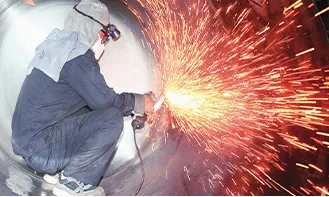welding electric rod
Understanding Welding Electric Rods Essentials for Optimal Performance
Welding is a crucial process in various industries, from automotive to construction, and ensuring robust and reliable joints is paramount. One vital component of the welding process is the welding electric rod—also known as welding electrodes. These rods are employed in various types of welding processes, including arc welding, and play a significant role in the quality and strength of the final weld. In this article, we will explore the different types of welding electric rods, their functions, and tips for optimal usage.
What is a Welding Electric Rod?
A welding electric rod is a metal bar coated with a shielding material, which is used in the arc welding process to create a weld between two metal parts. When an electric current is applied, the rod melts and fuses with the base materials, allowing for the formation of a solid joint. The coating on the rod serves multiple purposes, including stabilizing the arc, protecting the molten metal from contamination, and providing alloying elements that enhance the mechanical properties of the welded joint.
Types of Welding Electric Rods
Welding rods come in various types, each designed for specific applications and materials. Here are some of the most common types
1. Mild Steel Electrodes These rods are the most frequently used in welding applications. They are characterized by their good weldability and are suitable for a wide range of projects, including general fabrication and repair work.
2. Stainless Steel Electrodes Designed for welding stainless steel, these electrodes contain alloying elements such as chromium and nickel, which enhance corrosion resistance and overall durability. They are used extensively in food processing, marine, and chemical industries.
3. Cast Iron Electrodes These rods are specifically formulated to weld cast iron materials. They often contain a high carbon content to ensure compatibility with cast iron and to prevent cracking during the welding process.
4. Specialty Electrodes There are also many specialty electrodes that cater to specific needs, such as welding high-strength steels or providing high-temperature resistance. These rods may incorporate unique alloying elements tailored for niche applications.
Choosing the Right Welding Electric Rod
Selecting the appropriate welding electric rod is essential for achieving the desired results
. Here are several factors to considerwelding electric rod

- Material Compatibility Ensure that the electrode is compatible with the materials being welded. Using the wrong type can lead to inadequate bonding and decreased strength.
- Welding Position Different rods are designed for various welding positions—flat, horizontal, vertical, or overhead. Ensure that the chosen rod is suitable for the specific welding position you’ll be working in.
- Current Type Identify whether you will be using Direct Current (DC) or Alternating Current (AC) for your welding process. Some electrodes work better with one type than the other.
- Coating Type The coating affects the quality of the weld and the type of slag produced. Be sure to select an electrode with a coating that matches your welding requirements.
Tips for Optimal Usage
To maximize the efficiency and effectiveness of your welding electric rod, consider the following tips
1. Preheat Materials When welding thicker materials or low-alloy steels, preheating can reduce the risk of cracking and improve the quality of the weld.
2. Maintain Proper Arc Length A consistent arc length ensures molten metal transfer is optimal, reducing the chances of defects in the weld.
3. Storage Properly store your welding rods in a dry environment to prevent moisture absorption, which can lead to hydrogen-induced cracking during the welding process.
4. Skill Development Continuous practice and skill improvement are vital for mastering the art of welding. Invest time in honing your techniques for better results.
Conclusion
Welding electric rods are critical components in achieving strong and durable welds. By understanding the types of rods available, making the right selection based on your project’s requirements, and following best practices during usage, you can significantly enhance the quality of your welding work. Whether you are a seasoned welder or a novice, mastery of welding electric rods is essential for successful fabrications and repairs.
-
E6011 Welding Rod for Arc Welding – High Performance & VersatilityNewsJul.26,2025
-
Welding Rod 2.0 mm for Structural Welding - High Strength & PrecisionNewsJul.25,2025
-
Factory Supply Cast Iron Welding Rods AWS ENi-CI High StrengthNewsJul.24,2025
-
Premium 7018 Welding Rods Electrodes for Strong WeldsNewsJul.23,2025
-
E71T-1 Shielding Gas for Gas Shielded Cored Wire Welding SolutionsNewsJul.22,2025
-
Premium Submerged Arc Welding Wire | Efficient Quality SolutionNewsJul.21,2025


